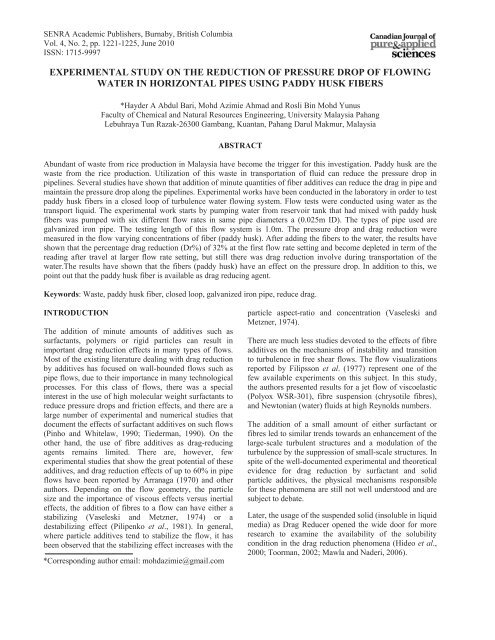Download (5Mb) - Covenant University Repository
Download (5Mb) - Covenant University Repository
Download (5Mb) - Covenant University Repository
Create successful ePaper yourself
Turn your PDF publications into a flip-book with our unique Google optimized e-Paper software.
SENRA Academic Publishers, Burnaby, British Columbia<br />
Vol. 4, No. 2, pp. 1221-1225, June 2010<br />
ISSN: 1715-9997<br />
EXPERIMENTAL STUDY ON THE REDUCTION OF PRESSURE DROP OF FLOWING<br />
WATER IN HORIZONTAL PIPES USING PADDY HUSK FIBERS<br />
*Hayder A Abdul Bari, Mohd Azimie Ahmad and Rosli Bin Mohd Yunus<br />
Faculty of Chemical and Natural Resources Engineering, <strong>University</strong> Malaysia Pahang<br />
Lebuhraya Tun Razak-26300 Gambang, Kuantan, Pahang Darul Makmur, Malaysia<br />
ABSTRACT<br />
Abundant of waste from rice production in Malaysia have become the trigger for this investigation. Paddy husk are the<br />
waste from the rice production. Utilization of this waste in transportation of fluid can reduce the pressure drop in<br />
pipelines. Several studies have shown that addition of minute quantities of fiber additives can reduce the drag in pipe and<br />
maintain the pressure drop along the pipelines. Experimental works have been conducted in the laboratory in order to test<br />
paddy husk fibers in a closed loop of turbulence water flowing system. Flow tests were conducted using water as the<br />
transport liquid. The experimental work starts by pumping water from reservoir tank that had mixed with paddy husk<br />
fibers was pumped with six different flow rates in same pipe diameters a (0.025m ID). The types of pipe used are<br />
galvanized iron pipe. The testing length of this flow system is 1.0m. The pressure drop and drag reduction were<br />
measured in the flow varying concentrations of fiber (paddy husk). After adding the fibers to the water, the results have<br />
shown that the percentage drag reduction (Dr%) of 32% at the first flow rate setting and become depleted in term of the<br />
reading after travel at larger flow rate setting, but still there was drag reduction involve during transportation of the<br />
water.The results have shown that the fibers (paddy husk) have an effect on the pressure drop. In addition to this, we<br />
point out that the paddy husk fiber is available as drag reducing agent.<br />
Keywords: Waste, paddy husk fiber, closed loop, galvanized iron pipe, reduce drag.<br />
INTRODUCTION<br />
The addition of minute amounts of additives such as<br />
surfactants, polymers or rigid particles can result in<br />
important drag reduction effects in many types of flows.<br />
Most of the existing literature dealing with drag reduction<br />
by additives has focused on wall-bounded flows such as<br />
pipe flows, due to their importance in many technological<br />
processes. For this class of flows, there was a special<br />
interest in the use of high molecular weight surfactants to<br />
reduce pressure drops and friction effects, and there are a<br />
large number of experimental and numerical studies that<br />
document the effects of surfactant additives on such flows<br />
(Pinho and Whitelaw, 1990; Tiederman, 1990). On the<br />
other hand, the use of fibre additives as drag-reducing<br />
agents remains limited. There are, however, few<br />
experimental studies that show the great potential of these<br />
additives, and drag reduction effects of up to 60% in pipe<br />
flows have been reported by Arranaga (1970) and other<br />
authors. Depending on the flow geometry, the particle<br />
size and the importance of viscous effects versus inertial<br />
effects, the addition of fibres to a flow can have either a<br />
stabilizing (Vaseleski and Metzner, 1974) or a<br />
destabilizing effect (Pilipenko et al., 1981). In general,<br />
where particle additives tend to stabilize the flow, it has<br />
been observed that the stabilizing effect increases with the<br />
*Corresponding author email: mohdazimie@gmail.com<br />
particle aspect-ratio and concentration (Vaseleski and<br />
Metzner, 1974).<br />
There are much less studies devoted to the effects of fibre<br />
additives on the mechanisms of instability and transition<br />
to turbulence in free shear flows. The flow visualizations<br />
reported by Filipsson et al. (1977) represent one of the<br />
few available experiments on this subject. In this study,<br />
the authors presented results for a jet flow of viscoelastic<br />
(Polyox WSR-301), fibre suspension (chrysotile fibres),<br />
and Newtonian (water) fluids at high Reynolds numbers.<br />
The addition of a small amount of either surfactant or<br />
fibres led to similar trends towards an enhancement of the<br />
large-scale turbulent structures and a modulation of the<br />
turbulence by the suppression of small-scale structures. In<br />
spite of the well-documented experimental and theoretical<br />
evidence for drag reduction by surfactant and solid<br />
particle additives, the physical mechanisms responsible<br />
for these phenomena are still not well understood and are<br />
subject to debate.<br />
Later, the usage of the suspended solid (insoluble in liquid<br />
media) as Drag Reducer opened the wide door for more<br />
research to examine the availability of the solubility<br />
condition in the drag reduction phenomena (Hideo et al.,<br />
2000; Toorman, 2002; Mawla and Naderi, 2006).

















